Jersey Geology Trail |
Dolerite. (Gk. dolos-eros = trick + lithos = stone). |
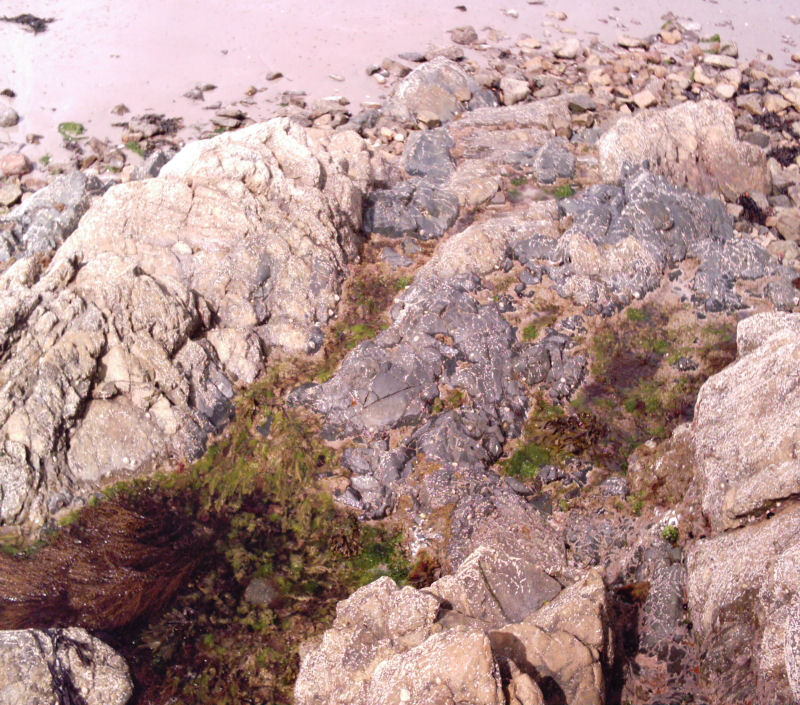 |
Bifurcated dolerite dyke below Le Saut Jeffroi. |
| |
Dolerite is a basic, minor intrusive igneous rock, with a medium crystalline texture and a generally medium to dark grey colour. It is composed of augite( pyroxene) with labradorite plagioclase feldspar and may also contain quartz or olivine, then termed a quartz or olivine dolerite. It can be intruded along bedding planes, joints and faults to form structures called sills and dykes respectively. In the USA, it is called diabase (Allaby & Allaby, 1999, p. 166)
In Jersey, this rock type crops out in the South East Igneous Complex as the Jersey Main Dyke Swarm which is beautifully exposed along the whole of the south coast. Comprehensive, detailed descriptions and analyses are given by Lees (1990, pp. 273 - 290). |
| |
 |
Dolerite dykes, Le Croc, La Motte (Gr. Is.). |
| |
Dolerite to Epidiorite (Metadolerite) Dykes, Pontac Beach, St. Clément. |
In the south east, the dolerites contain both fresh and altered augite and labradorite and also occasional hornblende. The crystal textures vary from aphyric (finely crystalline) similar to that of basalts, to porphyritic and ocellar (eye-shaped). Chlorite is also widespread as an alteration product of the hornblendes due to low grade regional metamorphism rather than weathering which can produce highly altered textures and a resemblance to epidiorites (Bishop & Bisson, 1989, p.62). These are not depicted on the BGS 1:25,000 map (1982) or in the Key, but are described in the footnotes under Minor Intrusions, and in the text (BGS, 1989, p. 61, 62) under Basic Intrusions. |
| |
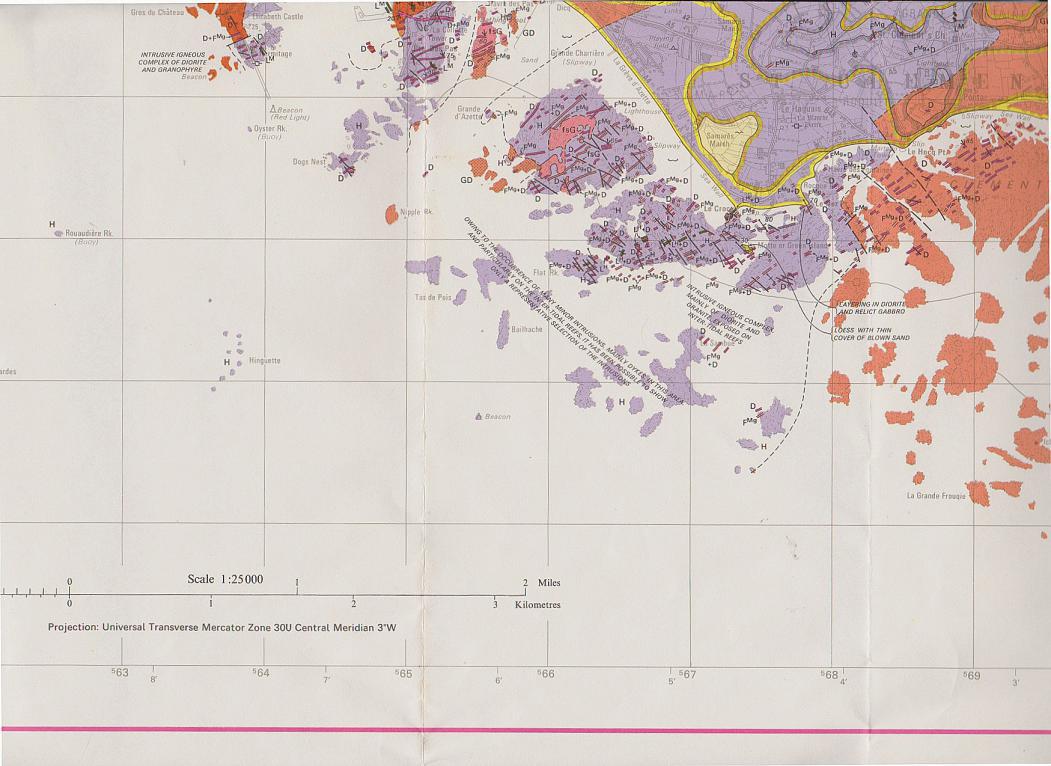 |
Fig. 1. (centre NE). |
| |
The majority of dykes in the Jersey Main Dyke Swarm consist of dark grey, micro - crystalline, Minor Intrusive Dolerite in vertical or steeply inclined structures (Fig. 2). However, in the Pontac area, SE of the slipway, several dykes consist of black and white - speckled, medium - crystalline rock, similar to a lighter (leuco) Diorite, a Plutonic Intermediate rock (Fig. 3). |
| |
 |
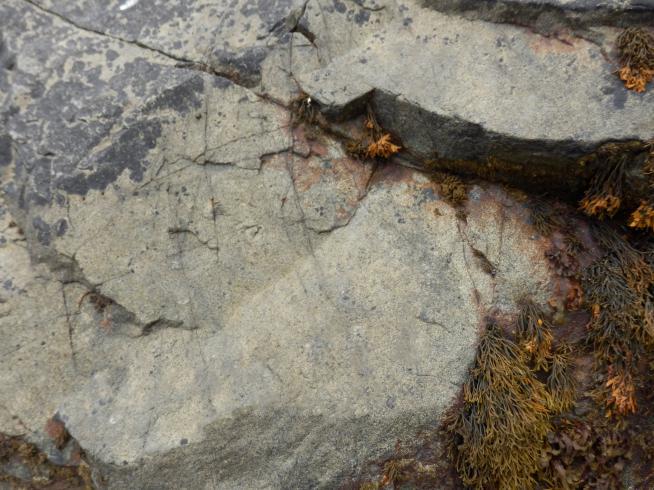 |
Fig. 2. |
Fig. 3. |
| |
These rocks are described as Epidiorites (also Metadolerites, op. cit.), that is, Dolerites which have been altered by low - grade metamorphism. During this process, heat, pressure, hot water and gases have selectively altered the mafic and feldspathic minerals in the Dolerites to larger mineral equivalents, characteristic of the Intermediate Plutonic Diorites (eg. Augite to Hornblende, Labradorite to Andesine). The colours and textures of these dyke rocks are similar to some of the Diorites which crop out within the granite between Le Hocq and La Motte (Green Is.) to the west but here, the low grade of metamorphism is also identified by the presence of several minerals, e.g. green chlorite and epidote (cross refer to Index Metamorphic Rocks).
This distinction may be useful when identifying rock types in nearby outcrops used to build Dolmens and Passage Graves.
For example, at Pontac, the isolated blocks of black and white speckled - looking Diorite in the beach structures near the slipway, may be blocks of Epidiorite from the well - jointed Dolerite dykes in the nearby islet, rather than from intrusive Diorites brought from La Motte (Green Is.) to the west.
The dolerite is not of uniform composition or crystal size and variations due to composite intrusion and chilling at the margins can be seen clearly in the dykes south of Le Hocq slipway (Nichols & Hill, 2004, p. 47 - 49). Composite dykes also occur, and generally have dark grey, doleritic margins and medium to light grey-pink quartz porphyry centres, but the more detailed composite arrangements of the dolerite (X) and porphyries (Y) are described in detail by Lees (loc. cit. p.277) and vary from XYX to XYXYX. Their contacts are sharply defined and rounded (lobate) or irregular (flame-like) and there are xenoliths and xenocrysts of each rock type within the other. Finer crystalline, possibly chilled, margins occur in some and they also intersect each other in places. They are normally vertical and strike c. NE-SW here in the eastern part of the Jersey Main Dyke Swarm.
At the south eastern corner near Seymour Tower, dolerite occurs in elongated lenses (pods) and has a uniform texture due to regional metamorphism (described as granoblastic). Small quartz xenocrysts also occur in these dykes possibly stemming from the intrusion of the adjacent granite.
Dolerite dykes can also be seen in the beach outcrops of the South West Igneous Complex in Ouaisné and Portelet Bays. In Ouaisné, a dolerite dyke in the low beach outcrop strikes c. E-W and its northern junction with the aplite granite strikingly demonstrates the way the intruding magma was controlled by the joint pattern. Dolerite dykes also crop out along the eastern side of Noirmont Point, Bouilly Port, Beauport and to the east and north of La Corbière Point at La Rosière and Le Grouet wave-cut platform respectively. |
| |
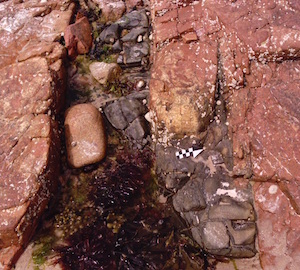 |
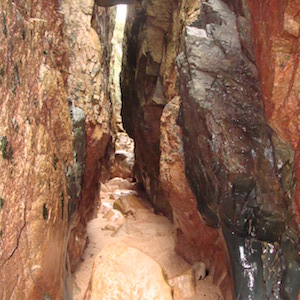 |
Dolerite dyke, Ouaisné. |
Dolerite dyke, Bouilly Port. |
| |
Dolerite also forms sills (or low-angled dykes) but in the North West Igneous Complex. They are well exposed in the granite from Le Pulec to Grosnez Point with the best being exposed from Le Pinacle, an ancient stack, northwards along the base of the adjacent landward cliffs. In contrast to the near vertical dykes of the south east, these dip to the south east at c. 10°. Only two examples occur on the south coast; one is a highly altered basic sill which crops out at the western end of Portelet Bay and further west by La Pointe du Fret and the other, a striking composite sill at La Collette on the south side of St. Helier. |
| |
|
References.
Allaby, A. & Allaby, M. 1999, A Dictionary of Earth Sciences. Oxford University Press.
Bishop, A. C. & Bisson, G. 1989. Classical areas of British geology: Jersey: description of 1;25,000 Channel Islands. Sheet 2. (London: HMSO for British Geological Survey).
Lees, G. J. 1990. The geochemical character of late Cadomian extensional magmatism in Jersey, Channel Islands, in D'Lemos, R. S., Strachan, R. A. and Topley, C. G. 1990. The Cadomian Orogeny. Geological Society Special Publication, No. 51. The Geological Society. London.
Nichols, R. A. H. & Hill, A. E. 2004. Jersey Geology Trail. Private publication printed by the Charlesworth Group. |
| |
| |
| |